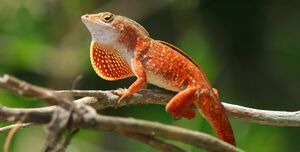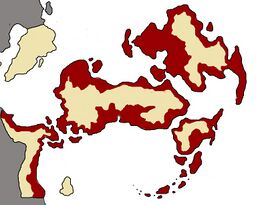Anolis panhumilis: Difference between revisions
ContraViper (talk | contribs) No edit summary |
ContraViper (talk | contribs) No edit summary |
||
| (One intermediate revision by the same user not shown) | |||
| Line 20: | Line 20: | ||
| range_map_caption= Range of ''A. panhumilis'' in [[Inyursta]]<br><small> | | range_map_caption= Range of ''A. panhumilis'' in [[Inyursta]]<br><small> | ||
}} | }} | ||
The '''Coastal Red Anole''' (''Anolis panhumilis'') is a species of {{wp|Anolis|Anole}} found in most eastern lowlands across [[Ameríca Libré]], including the coastal regions of [[Inyursta]] and [[Gran Cuscatlan]]. Also known simply as the "'''Coastal Red'''" or "''' | The '''Coastal Red Anole''' (''Anolis panhumilis'') is a species of {{wp|Anolis|Anole}} found in most eastern lowlands across [[Ameríca Libré]], including the coastal regions of [[Inyursta]] and [[Gran Cuscatlan]]. Also known simply as the "'''Coastal Red'''" or "'''Lijarté Rouje'''", this species is known for its reddish coloration which ranges from a terra-cotta or pinkish color in some individuals to a saturated ruby-red in others (particularly males). | ||
One of the larger ''Anolis'' species, males can reach up to 21.6cm (8.5in), while females usually max out at around 12.7cm (5in). | One of the larger ''Anolis'' species, males can reach up to 21.6cm (8.5in), while females usually max out at around 12.7cm (5in). | ||
| Line 36: | Line 36: | ||
==Miscellaneous== | ==Miscellaneous== | ||
In 1976-1978, the Maoist regime in Cuscatlan under | In 1976-1978, the Maoist regime in Cuscatlan under Eduardo Vega de la Cruz initiated a program to exterminate this species due its "innate capitalist values" and "instinctive property addiction". Due to high reproductive rates compared with the costs of paying people to chase and kill lizards all day, this program was a wide failure outside of a select few cities (which were all then repopulated by A. panhumilis within two to five years of [[Raul Martinez|Martinez's Coup]].) | ||
==See Also== | ==See Also== | ||
===Similar Species=== | ===Similar Species=== | ||
[[Anolis clavoviridis|Hatched Forest anole (Anolis clavoviridis)]] | [[Anolis clavoviridis|Hatched Forest anole (''Anolis clavoviridis'')]]<br /> | ||
[[Anolis silva|Cuscatlani Forest Anole (Anolis silva)]] | [[Anolis silva|Cuscatlani Forest Anole (''Anolis silva'')]]<br /> | ||
[[Anolis lorenzianus|Islė Lorenzo Anole (''Anolis lorenzianus'')]] | |||
===Inyurstan Species Lists=== | |||
[[Inyurstan Herpofaunal Checklist]]<br /> | |||
[[Species Endemic to Inyursta]] | |||
[[Category:Inyurstan Wildlife]] [[Category:Inyursta]] | [[Category:Inyurstan Wildlife]] [[Category:Inyursta]] | ||
Latest revision as of 10:53, 12 February 2022
| Coastal Red Anole | |
|---|---|

| |
| Male Coastal Red anole displaying his dewlap. | |
| Scientific classification | |
| Kingdom: | Animalia
|
| Phylum: | Chordata
|
| Class: | Reptilia
|
| Order: | Squamata
|
| Family: | Dactyloidae
|
| Genus: | Anolis
|
| Species: | A. panhumilis
|
| Binomial name | |
| Anolis panhumilis | |

| |
| Range of A. panhumilis in Inyursta | |
The Coastal Red Anole (Anolis panhumilis) is a species of Anole found in most eastern lowlands across Ameríca Libré, including the coastal regions of Inyursta and Gran Cuscatlan. Also known simply as the "Coastal Red" or "Lijarté Rouje", this species is known for its reddish coloration which ranges from a terra-cotta or pinkish color in some individuals to a saturated ruby-red in others (particularly males).
One of the larger Anolis species, males can reach up to 21.6cm (8.5in), while females usually max out at around 12.7cm (5in).
Range
This species is usually found in most coastal habitats, such as tropical dry forests and dune hammocks, but can also be found in deep jungles or mangrove forests. Populations persist in abundance in areas that have been developed, especially in green spaces such as gardens, parks or even vacant lots.
Native
One of the top 20 most widely distributed species in the region, A. panhumilis can be found in every east-coast country from the Sea of Juarez south through Inyursta and Cuscatlan into...
Introduced
Breeding populations of the Coastal Red anole have been established in southern port cities of the Eulabian Union and some island nations of the South Furukawan Sea, including South Oceanica. Most populations have been established through stow-away individuals travelling in shipping crates (such as agriculture or produce), though the possibility of animals released from captivity has not been ruled out - especially in countries that have little or no trade with those in Ameríca Libré.
Behavior
A highly aggressive species, male Coastal Red anoles will often engage in combat with one another over territory. They are also known to chase other similar sympatric lizards, such as the Brown anole or Juarez Dwarf iguana out of their claimed turf. They will always show their dewlap in the face of perceived territorial threats, even passive species such as opossums and crabs, and sometimes against potential predators.
Males will attempt to claim a territory of usually 20-40m2, though in the absence of other males or active predators they claim even larger tracts of land. Females will carelessly move between tracts of male territory, often mating with multiple males in a season. 3-7 eggs are laid at a time, and an adult female may lay up to three clusters of eggs in a year. Breeding usually occurs from two months prior to the dry season to one month into the rainy season, likely so that juveniles are born into the resource-abundant rainy season.
Miscellaneous
In 1976-1978, the Maoist regime in Cuscatlan under Eduardo Vega de la Cruz initiated a program to exterminate this species due its "innate capitalist values" and "instinctive property addiction". Due to high reproductive rates compared with the costs of paying people to chase and kill lizards all day, this program was a wide failure outside of a select few cities (which were all then repopulated by A. panhumilis within two to five years of Martinez's Coup.)
See Also
Similar Species
Hatched Forest anole (Anolis clavoviridis)
Cuscatlani Forest Anole (Anolis silva)
Islė Lorenzo Anole (Anolis lorenzianus)